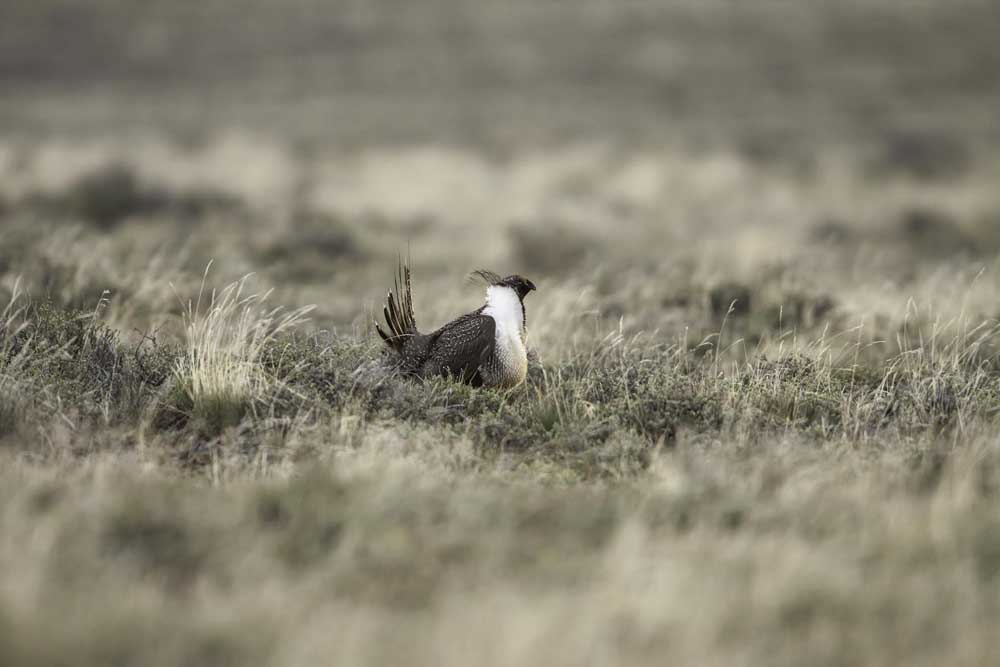Sage grouse leks attract polite, hushed birders
Published 12:00 am Thursday, May 10, 2018

- A greater sage grouse male makes a strutting display at a lek, or breeding ground. Early each year, males develop yellow, mango-sized air sacs on their white chests, which they bounce while fanning their tail feathers. It’s a striking display of dominance. Birder Matt Lee took this photograph near Malheur National Wildlife Refuge on May 12, 2011. (Submitted photo / Matt Lee)Matt Lee, a
The birders turned off the headlights before easing their vehicles along the dirt road. When they reached their destination, they angled the cars just so and killed the engines. At 5:30 a.m., the birders were intent on observing — without being observed — a greater sage grouse mating area, called a lek, which was about 100 yards away.
“We’ll just be whispering from now on,” said Judy Meredith, 70, an East Cascades Audubon Society member, twisting in her driver’s seat. Matt Lee and Sue Powell, birdwatchers visiting from Corvallis, nodded.
Trending
The morning before, all three birders had made a test run from Bend to the range near Pine Mountain. The range represents the westernmost edge of sage grouse habitat. Powell and Lee were intent on training their powerful digital cameras — one of which was equipped with a traffic cone-sized telescopic lens — at the famous courtship ritual.
Before dawn, a group of sage grouse had already convened. With the naked eye they were barely more than white specks; with the help of binoculars, the sage grouse’s regal weirdness appeared in full.
“There, by the (pallets),” Meredith said, peering through binoculars. She’s been leading about five viewing parties each spring at this location for nearly 10 years. There are five males.
Male sage grouse range in length from 22 to 30 inches, head to tail. The females are smaller. The bird is chickenlike, with long, broad wings and a long pointed tail. They’re a mottled brown, black and white overall, with a black belly and a large, heavy bill, according to “Birds of the Pacific Northwest,” by John Shewey and Tim Blount.
During the mating season each spring, the males develop yellow, mango-sized air sacs on their white chests. The birds bounce the sacs while fanning their tail feathers. It’s a striking display of dominance.
Doing so creates a loose, floppy sound, like someone turning over a hot water bottle, or kicking a half-full milk jug.
Trending
“I can just barely hear the males,” Lee said.
This isn’t the only lek in the area, Meredith said, but the other two are too far onto private property to view. Much of the sage grouse’s habitat, and particularly their lek areas, which they return to year after year, have been displaced by agriculture, livestock and recreation. But here, an expanse of rabbitbrush was interrupted only by rock outcroppings and a fence that a team of Audubon Society members tagged with markers in recent years so the low-flying sage grouse wouldn’t collide with it. Last year, East Cascades Audubon Society, in cooperation with the Bureau of Land Management, placed markers on 3.6 miles of fence.
Overhead, the darkness gave way to gold and blue streaks that would soon make up the morning sky. Unseen sage thrashers, the high desert’s most recognizable and melodious songbird, whistled and trilled. More males trickled into the lek, numbering seven. They circled each other, glug-glugging their chests. The birders suspected a female, known only to the males, was watching the pageantry from a hiding spot among the rabbitbrush. Their cameras remained on their laps as they peered through binoculars, withstanding the pins and needles of blood draining from their hands.
In about 40 years of lek watching, Meredith has glimpsed some rare sights. On occasion, she’s seen pairs copulate. Others have viciously fought.
“These two males were fighting. One tore the other’s air sac,” Meredith said. “It was bleeding and wouldn’t inflate, but he was still trying to display anyway.”
In a lek, mating happens when a female selects a male by walking up to it. Then they walk out of sight to procreate. The female lays eggs under the relative protection of thicker sagebrush, which they arrive at from the lek after a short flight. Sage grouse subsist on wild flowers, forbs — or herbaceous flowering plants — and insects. The females must forage and hunt while keeping an eye out for the coyotes and ravens that prey on their eggs and chicks — new generations whose survival is increasingly crucial for the bird.
Sage grouse once numbered around 14 million throughout the northwestern and western states. The bird’s population now hovers around 425,000. Thirty-eight percent of sage grouse habitat is in Oregon, according to the Bureau of Land Management. In September 2015, the U.S. Fish and Wildlife Service determined that sage grouse did not warrant listing under the Endangered Species Act of 1973. That’s when the Audubon Society stepped up its effort to tag fence lines and place approved water guzzlers throughout BLM land and lower sections of the Deschutes National Forest.
Still, other forces conspire against the sage grouse. Central Oregon’s ever-expanding population inevitably means a greater presence of outdoor recreationists, including ATV riders and regulars at the nearby paintball range, not far from this lek. Some biologists even fault overeager birders who get too close to leks for the dwindling sage grouse numbers, Meredith said. The invasive cheatgrass has even displaced the wildflowers.
“Everything is going wrong for these birds,” she said.
The birding group remained unnoticed by the birds each time they visited. Prior to this morning, a total of six birds was the most-attended lek this season, according to the society’s observations.
“We used to get 50, 33, 18, 12 — goes down fast,” Meredith said.
The bird-watching continued. The males circled, faced off, fluffed their chests. Some retreated.
“One just walked away,” Lee said. “I was hoping he’d come closer.”
“Take a picture of the two facing each other,” Powell said.
“It’s too far,” Lee said.
“It would be better than nothing,” Powell said.
Lee placed a terrycloth towel on the door’s ledge, where he rested his heavy lens.
“Get them together,” Powell said.
“Yep,” Lee said.
Time was punctuated by the sound of a stifled cough, an airplane, a cow bellowing and the rustling of one’s jacket while adjusting positions in the car seats.
“That’d make a nice profile with their tails up and the air sacs,” Meredith said.
“Shoot video,” Powell said.
“No,” Lee said. He pulled away from the camera and scrolled through his recent images. The grouse’s
air sacs are distended, but the head-on angle makes them both appear flat. Lee flicked his camera back and squeezed off some more shots.
The birders don’t leave until all the sage grouse leave the lek.
Sometimes they sit observing for hours. Other times, for less than 30 minutes. On this morning, the lek session was over by 7:15.
The birders backed up their vehicles and slowly rolled away.
They would spend the rest of the morning hiking to Pumice Springs, where they spotted 45 additional bird species, including Brewer’s sparrow, Lewis’ woodpecker and a prairie falcon.
After leading three early-morning lek viewings in a row, Meredith said the lack of sleep was beginning to add up.
“But it’s an energizer to start the day with such a spectacular bird,” Meredith said. “You could spend a morning at home drinking coffee and doing laundry, but in the desert there are lots of birds singing in the first hours of the day. It’s a positive upper experience to be out there. I pick the birds.”
— Reporter: 541-617-7816, pmadsen@bendbulletin.com








